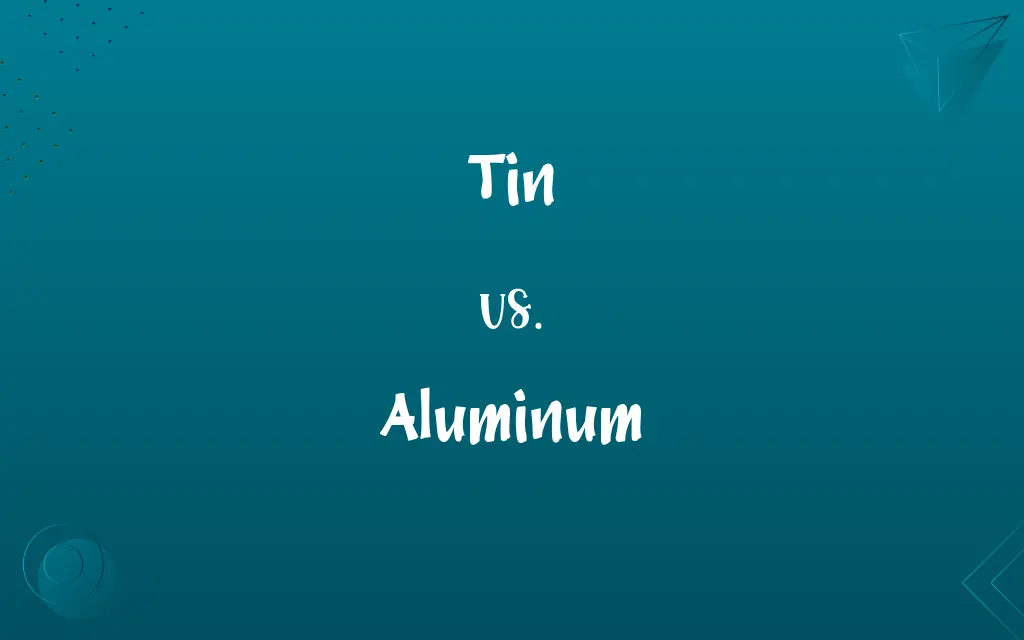Tin vs. Aluminum: Know the Difference

By Dua Fatima & Shumaila Saeed || Published on May 4, 2024
Tin is a soft, malleable metal often used for coating, while aluminum is lightweight and strong, favored in construction and packaging.

Key Differences
Tin, a chemical element with the symbol Sn, is known for its corrosion resistance and malleability, making it ideal for tin plating and creating alloys such as bronze. Aluminum, represented by the symbol Al, stands out for its lightweight nature and strength, making it a preferred material in aerospace, construction, and transportation industries.
Dua Fatima
May 04, 2024
While tin has been historically significant for its use in tin cans and pewter, aluminum's abundant availability and recyclability have made it a modern choice for packaging, including beverage cans and foil. Whereas tin's applications lean towards protective coatings and solder, emphasizing its resistance to corrosion and low toxicity.
Shumaila Saeed
May 04, 2024
Tin's lower melting point (231.9°C) makes it suitable for applications requiring lower processing temperatures, such as soldering electronics. On the other hand, aluminum, with a melting point of 660.3°C, is used in high-temperature processes and manufacturing lightweight, durable components.
Dua Fatima
May 04, 2024
In terms of abundance, tin is relatively rare and primarily obtained from the mineral cassiterite, whereas aluminum is the most abundant metal in the Earth's crust, mainly derived from bauxite ore, highlighting differences in their sourcing and economic value.
Dua Fatima
May 04, 2024
Tin's historical value in creating alloys and coatings, aluminum dominates modern industrial applications due to its versatility, strength, and environmental friendliness, showcasing the shift in material preference over time.
Hifza Nasir
May 04, 2024
ADVERTISEMENT
Comparison Chart
Common Uses
Tin plating, solder, bronze alloy
Aerospace, packaging, construction
Dua Fatima
May 04, 2024
ADVERTISEMENT
Corrosion Resistance
High, especially in coatings
Naturally forms oxide layer for protection
Dua Fatima
May 04, 2024
ADVERTISEMENT
Tin and Aluminum Definitions
Tin
Obtained primarily from the mineral cassiterite.
Cassiterite is mined for extracting tin.
Hifza Nasir
Mar 05, 2024
Aluminum
A lightweight, strong metal widely used in various industries.
Aluminum is favored for making aircraft due to its strength-to-weight ratio.
Dua Fatima
Mar 05, 2024
Tin
A soft, malleable metal used mainly for plating and alloys.
Tin is often used to coat other metals to prevent corrosion.
Dua Fatima
Mar 05, 2024
Aluminum
Abundant and recyclable, making it environmentally friendly.
Aluminum cans are widely recycled, reducing the need for raw material mining.
Shumaila Saeed
Mar 05, 2024
Tin
Historically significant for its use in bronze.
Tin and copper are combined to make bronze, an important alloy since ancient times.
Dua Fatima
Mar 05, 2024
Aluminum
Used in construction for its durability and lightness.
Aluminum frames are commonly used in modern buildings for their lightweight and strength.
Dua Fatima
Mar 05, 2024
Tin
Has a low toxicity and is used in food packaging.
Tin plating is applied to steel cans to prevent rusting.
Dua Fatima
Mar 05, 2024
Aluminum
Forms a protective oxide layer, resisting corrosion.
Aluminum's natural oxide layer protects it from rusting.
Dua Fatima
Mar 05, 2024
Tin
Less common and more expensive than some metals.
Due to its rarity, tin is a valuable material in the metals market.
Shumaila Saeed
Mar 05, 2024
Aluminum
Melts at a higher temperature than tin.
Aluminum's higher melting point makes it suitable for automotive parts.
Shumaila Saeed
Mar 05, 2024
Aluminum
A silvery-white, ductile metallic element, the most abundant in the earth's crust but found only in combination, chiefly in bauxite. Having good conductive and thermal properties, it is used to form many hard, light, corrosion-resistant alloys. Atomic number 13; atomic weight 26.9815; melting point 660.32°C; boiling point 2,519°C; specific gravity 2.70; valence 3. See Periodic Table.
Dua Fatima
Mar 05, 2024
Aluminum
The metallic element forming the base of alumina. This metal is white, but with a bluish tinge, and is remarkable for its resistance to oxidation, and for its lightness, having a specific gravity of about 2.6. Atomic weight 27.08. Symbol Al. Also called aluminium.
Dua Fatima
Mar 05, 2024
Tin
An airtight container, made of tin or another metal, used to preserve food, or hold a liquid or some other product.
A tin of baked beans; a tobacco tin; a tin of shoe polish
Empty tins, cans, and plastic containers are recycled in the blue bins.
Hifza Nasir
Mar 05, 2024
Tin
A silvery malleable metallic element that resists corrosion; used in many alloys and to coat other metals to prevent corrosion; obtained chiefly from cassiterite where it occurs as tin oxide
Dua Fatima
Mar 05, 2024
Repeatedly Asked Queries
What are the melting points of tin and aluminum?
Tin melts at 231.9°C, while aluminum melts at 660.3°C.
Hifza Nasir
May 04, 2024
Why is aluminum preferred in construction?
Aluminum is preferred for its lightweight, strength, and resistance to corrosion.
Dua Fatima
May 04, 2024
How are tin and aluminum obtained?
Tin is obtained from cassiterite, and aluminum is derived from bauxite ore.
Shumaila Saeed
May 04, 2024
Why is aluminum used in aerospace?
Its lightweight and strong nature make it ideal for aerospace applications.
Dua Fatima
May 04, 2024
Do tin and aluminum have similar densities?
No, tin is denser (7.31 g/cm³) compared to aluminum (2.70 g/cm³).
Hifza Nasir
May 04, 2024
Can tin and aluminum be recycled?
Yes, both tin and aluminum are recyclable, but aluminum is more widely recycled.
Dua Fatima
May 04, 2024
Is tin more expensive than aluminum?
Generally, yes, due to its rarity compared to aluminum's abundance.
Dua Fatima
May 04, 2024
Which metal has a higher economic value?
Aluminum, due to its widespread industrial use and recyclability.
Dua Fatima
May 04, 2024
Can tin and aluminum be used interchangeably?
No, their properties and applications differ significantly, making them suitable for different uses.
Dua Fatima
May 04, 2024
What is tin primarily used for?
Tin is primarily used for plating to prevent corrosion and in alloys like bronze.
Shumaila Saeed
May 04, 2024
Why is tin used in food packaging?
Its corrosion resistance and low toxicity make it suitable for coating steel cans.
Dua Fatima
May 04, 2024
What makes aluminum environmentally friendly?
Its abundance, recyclability, and the energy efficiency in recycling process.
Dua Fatima
May 04, 2024
What role does tin play in soldering?
Tin is a primary component in solder due to its low melting point and good bonding properties.
Hifza Nasir
May 04, 2024
Are there any health risks associated with tin?
Tin is considered low in toxicity, especially in the form used for tin plating.
Shumaila Saeed
May 04, 2024
How does the corrosion resistance of tin and aluminum compare?
Both metals resist corrosion well, but aluminum forms a protective oxide layer naturally.
Dua Fatima
May 04, 2024
Share this page
Link for your blog / website
HTML
Link to share via messenger
About Author
Written by
Dua FatimaCo-written by
Shumaila SaeedShumaila Saeed, an expert content creator with 6 years of experience, specializes in distilling complex topics into easily digestible comparisons, shining a light on the nuances that both inform and educate readers with clarity and accuracy.








































































